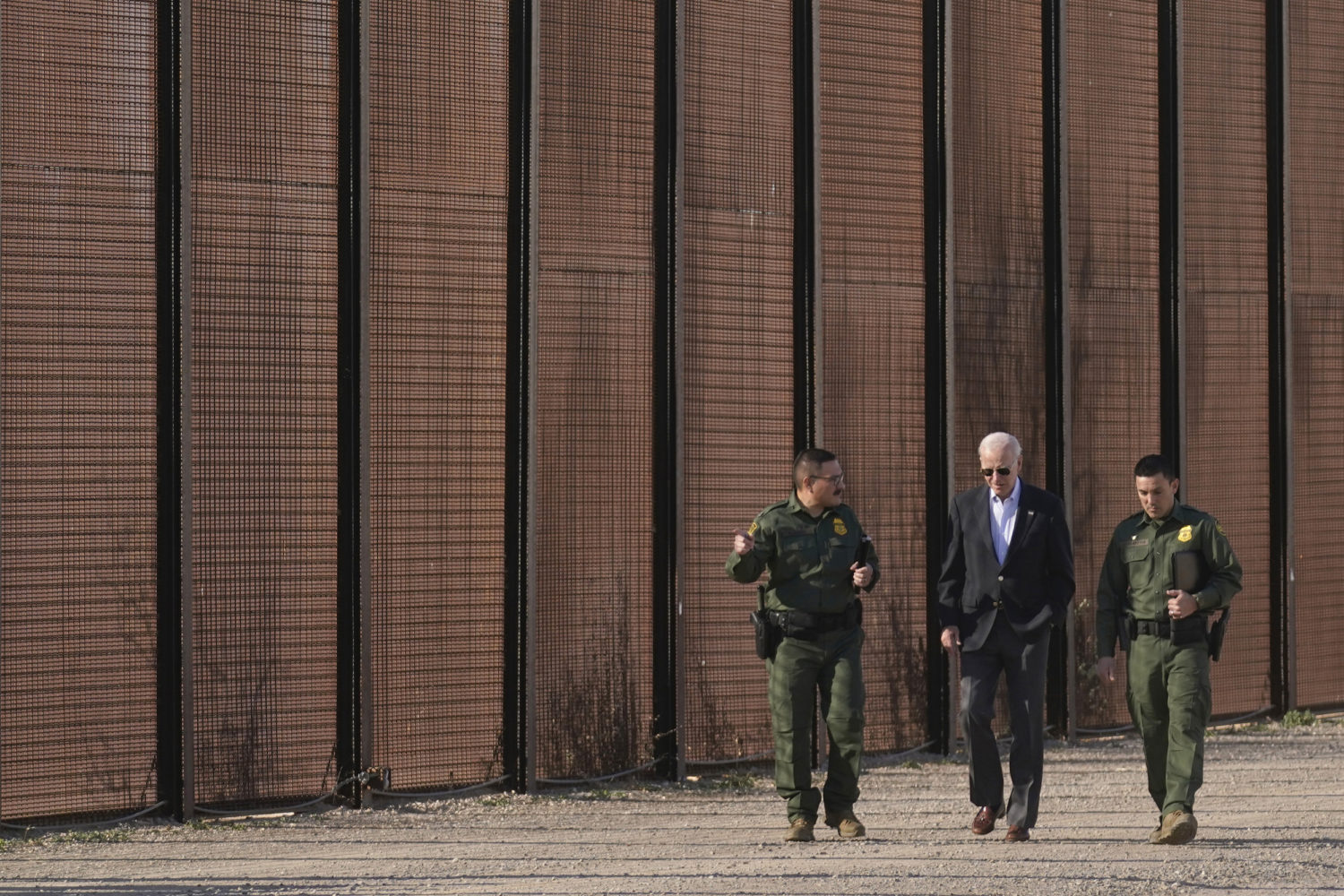President Joe Biden may have been seeking a bipartisan solution to America’s staggering fentanyl crisis when he raised the issue at his State of the Union address Feb. 8. But some lawmakers in the audience immediately tried to lay blame at his feet.
“Fentanyl is killing more than 70,000 Americans a year,” the president said after introducing a father who lost his 20-year-old daughter to the drug.
There was an immediate uproar from Republican lawmakers, with some shouting “border” at Biden. Rep. Andy Ogles, R-Tenn., yelled, “It’s your fault!”
It was a sentiment echoed by many Republican politicians and others on social media in the aftermath of Biden’s address.
Kayleigh McEnany, a former press secretary for Donald Trump and now a Fox News contributor, wrote in a Feb. 7 Facebook post, “Joe Biden: ‘Fentanyl is killing more than 70,000 Americans a year.’ Why? Because of Joe Biden’s wide open southern border he has done nothing to fix!”
The post was flagged as part of Facebook’s efforts to combat false news and misinformation on its News Feed. (Read more about our partnership with Meta, which owns Facebook and Instagram.
Although U.S. deaths from fentanyl, a powerful synthetic opioid, have risen sharply since Biden took office, data shows they’ve been increasing for the past decade, including during the Trump administration. Immigration encounters at the southern border have escalated under Biden, but the southern border is not open. Experts say the vast majority of fentanyl being smuggled in comes through ports of entry, not people trying to sneak into the country.
Sanho Tree, a fellow at the Institute for Policy Studies, a progressive Washington, D.C.-based think tank, said conflating migrants and drugs is an “old script” pushed for political advantage by Republicans.
Fentanyl “is not carried on the backs of migrants. Drug traffickers deal with professionals, not amateurs, and they prefer U.S. citizens,” he said.
Fentanyl deaths in the U.S.
Alexandra Coscia, a Fox News spokesperson for McEnany, pointed us to several articles, including one from PolitiFact, that show the scope of the fentanyl crisis, as well as data showing yearly increases in the amount of the drug seized at the border. In 2021, according to a Washington Post article Coscia sent us, more than 100,000 people died from drug overdoses in the U.S. — two-thirds were from fentanyl — and the number of people killed by the drug has climbed 94% since 2019.
But that article, an overview of a multiple-part investigation by the Post, also blamed “successive administrations” for failing to detect the growing problem. It links to another Post article that said, “Presidents from both parties failed to take effective action in the face of one of the most urgent threats to the nation’s security.”
There were 71,238 U.S. deaths from synthetic drugs, mostly fentanyl, in 2021, according to the most recent data available from the Centers for Disease Control and Prevention. That is a 23% increase from 2020, Trump’s final year in office, when there were 57,834 deaths. Overdose deaths from fentanyl and other drugs have been rising since 2014, according to CDC data.

(PolitiFact)
Why is fentanyl so deadly? Adam Isacson, defense oversight director at the Washington Office on Latin America, a research and human rights advocacy group, said the U.S. seems to be in what he called “the third wave of the 21st century opioid crisis.”
After prescription opioids, “pill mills” and heroin, he said, “traffickers have found fentanyl even easier to produce — no need to plant poppy fields,” he said.
“Each wave of opioid is even more concentrated than the last, requiring smaller and smaller amounts to get high — or to overdose. It’s just too easy and cheap now to accidentally administer a fatal dose,” Isacson said.
Drug users often don’t know exactly what they’re taking, he said. “It’s not like there’s a label” showing the contents.
Most fentanyl is smuggled across the southern border, but not by immigrants
Most illegally sourced fentanyl in the U.S. comes from Mexico through the southern border. Fentanyl seizures at the border have been rising since fiscal year 2015. Most recently, fentanyl seizures climbed from 11,200 in fiscal year 2021 to 14,700 in 2022, U.S. Customs and Border Protection data shows.
So far in fiscal year 2023, which started in October, border officials have seized more than 9,400 pounds of fentanyl. In November alone, 4,500 pounds were seized, nearly as much as was seized in all of fiscal year 2020.
Most fentanyl is smuggled at ports of entry by U.S. citizens, not by immigrants crossing the border illegally. About 9,100 pounds of the 9,400 seized so far this fiscal year were seized there.
“The drug cartels have no need to send the drugs with people who are crossing the border without authorization,” said Michelle Mittelstadt, communications and public affairs director at the Migration Policy Institute. “They are able to reach the U.S. market with ever-rising quantities of fentanyl by going through official crossings.”
Immigrants who seek asylum and turn themselves in to authorities at the border are “not suitable contraband carriers,” said Josiah Heyman, director of the Center for Inter-American and Border Studies at the University of Texas at El Paso. Neither are people who sneak into the country between ports of entries. Those immigrants are often arrested, and some get lost or die in the desert, he said.
“Drug smuggling operations don’t want that sort of loss,” said Heyman, adding that they prefer to smuggle the drugs in vehicles through ports of entry.
Although a lot of fentanyl is seized at ports of entry, some obviously gets through. Even a limited rate of smuggling success “is easily enough to supply U.S. demand,” Heyman said.
Isacson said although “we can’t know what’s not getting caught,” it’s likely that seizure data at the border “points to trends by showing a small share of total traffic.”
The southern border isn’t ‘wide open’
There have been 4.5 million encounters with migrants at the southern border between February 2021, Biden’s first full month in office, and December 2022. But McEnany is wrong to suggest that’s because the border has been “wide open” since he took office, a claim we’ve tackled several times.
The Biden administration continues to enforce immigration laws and policies at the border, including Title 42, a public health policy that has so far quickly expelled more than 2.1 million immigrants. There are also fences, drones and surveillance technology, as well as about 20,000 U.S. Border Patrol agents who help limit who and what comes into the United States.
Border security funding under Biden is comparable to funding under Trump’s administration. An omnibus spending bill passed in December will provide $16.7 billion for Customs and Border Protection in fiscal year 2023. That includes $88 million to increase personnel between ports of entry and $60 million to hire hundreds of border patrol officers and other staff.
What more can be done at the border?
McEnany didn’t say what specific border policies Biden should change. Ogles, who shouted that the fentanyl deaths were Biden’s fault, later told The Hill that Biden could “close that border with a stroke of a pen.”
Mittelstadt said closing the southern border as Ogles suggests would require shutting down all entries and crossings along nearly 2,000 miles, including to legal traffic. She said the “policy conversation would have a better chance of succeeding” if it focused on better detection at ports of entry, better intelligence collection, disruption of drug cartel activities and more anti-corruption efforts.
The Biden administration is touting investments to scan more vehicles at ports of entry and enlisting help from Mexico and other countries to disrupt suppliers.
“It will require a highly sustained and well-resourced set of operations to make a dent in fentanyl trafficking,” Mittelstadt said. “There clearly is an incentive for Congress and the administration to work cooperatively together to provide adequate resources to respond effectively.”
Heyman said short-term solutions to stopping the fentanyl crisis include rooting out corruption in U.S. border agencies and law enforcement. In the long run, he said, the U.S. needs better “public health approaches to shrink the demand for hard drugs.”
Isacson said there’s not much Biden could have done in two years to dramatically slow the increased fentanyl flow through the southern border, except for perhaps “a more rapid installation of detection technologies,” including drug-sniffing dogs. Such equipment has been coming on line, which is partly why there are increased seizures, he said.
The border is “one link on the chain,” Isacson said. Another is making addiction treatment more available to tamp down demand. More solutions lie beyond the border, he said.
“A more effective approach would start well south of the border,” he said, “addressing corruption and other law-enforcement and intelligence weaknesses in Mexico, including proliferation of Chinese-made precursors, that have allowed fentanyl and other synthetic drug production to thrive there.”
Precursors are chemicals used to manufacture illicit drugs such as fentanyl. Last year, the U.N. Commission on Narcotic Drugs voted to control three chemicals used by drug traffickers to produce fentanyl.
Our ruling
McEnany said in a Facebook post that “Joe Biden’s wide open southern border” is to blame for fentanyl deaths in the U.S.
Fentanyl deaths in the U.S. were rising before Biden took office but have increased during his administration. But there’s no evidence the border is “wide open” under Biden. Funding for border security and border patrol staffing has remained largely on par with the Trump administration.
Although more migrants have attempted to enter the U.S. illegally under Biden, experts said those people are not the ones smuggling fentanyl into the country. The drugs, trafficked by Mexican cartels, are generally coming through legal ports of entry, experts say and data shows. About 86% of federal fentanyl trafficking arrests were of U.S. citizens, data shows.
We rate the claim False
This fact check was originally published by PolitiFact, which is part of the Poynter Institute. See the sources for this fact check here.







